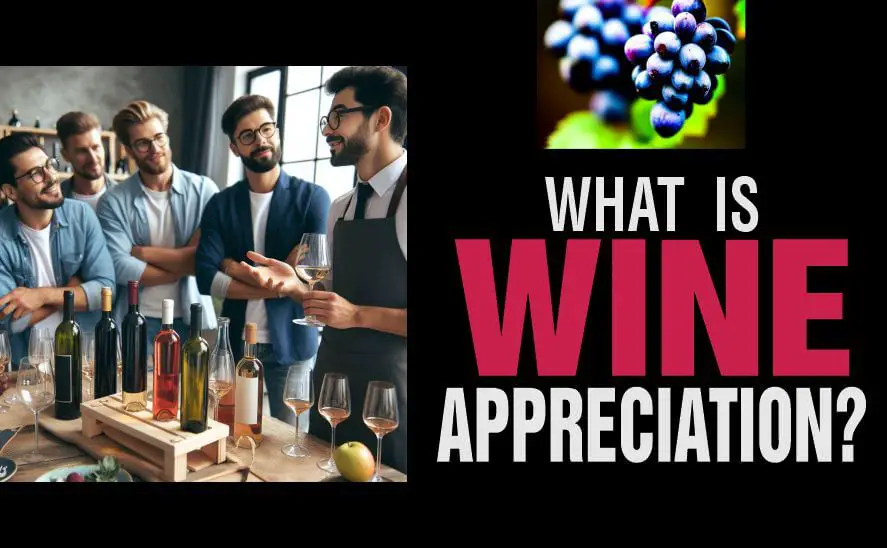Last updated on February 16th, 2024 at 10:33 am
As a gentleman, understand the basics of wine appreciation, where every bottle holds a story and every sip is an exploration of culture, history, and craftsmanship.
Whether you’re a seasoned oenophile or a curious novice, the art of wine appreciation invites you to savour the agelong moments of this timeless libation.
In this article, we are going to dive deep and uncork wine appreciation and the nuances of tasting.
Also, you will discover the art of pairing, all while cultivating a deeper understanding and admiration for the noble grape.
Recommended: The Four Major Types of Wine
Table of Contents
- Watch this Video on Tips for Wine Appreciation and Tasting (5mins 33sec)
- My Dad’s Love for Wines
- What is Wine Appreciation?
- Brief History of Wine Appreciation
- Importance of Wine Appreciation for Gentlemen
- The Basics of Wine Appreciation
- The Sensory Experience of Wine
- The Visual Appeal: Observing the Color and Body of Wine
- Colour
- Cultivating a Deeper Wine Appreciation
- Wine as a Conversation Starter: Promoting Engaging Discussions
- Building Your Wine Collection
- The Art of Sharing and Celebrating Wine
- Frequently Asked Questions
- Final Word
Watch this Video on Tips for Wine Appreciation and Tasting (5mins 33sec)

Wine 101: 10 Tips for Tasting & Appreciating Wine by Brainscape Wine
My Dad’s Love for Wines
My dad had a special love for wines. He always had some bottles of wine tucked away in a very safe cabinet which he unveiled with the visit of an important person in the house.
He treated wines with utmost respect and love. He taught me to love and appreciate wines.
Though he was not a fan of alcoholic wines, he assembled all types so his visitors would be pleased they visited.
From him, I learnt to pay homage to wines and treat them with the gentlemanly touch they deserve.
Related: White Wines: Types and Characteristics
What is Wine Appreciation?
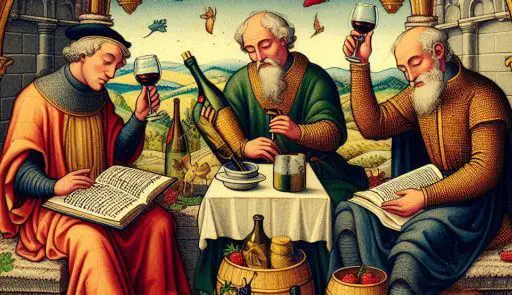
Wine appreciation is the art and practice of savouring and understanding wine.
It involves developing a discerning palate, exploring the diverse characteristics of different grape varietals, and understanding the influence of terroir and winemaking techniques on the final product.
Wine appreciation covers the sensory experience of tasting, smelling, and observing the color and body of wine, as well as the cultural and historical context of winemaking traditions.
It also involves learning about food and wine pairing, the art of serving and storing wine, and gaining a deeper appreciation for the craftsmanship and artistry that goes into producing this celebrated beverage.
Related: Characteristics of the Red Wine
Brief History of Wine Appreciation
Wine appreciation can be traced back thousands of years to ancient civilizations.
The origins of wine production and consumption can be found in countries such as Mesopotamia (modern-day Iraq) and ancient Egypt, where fermented grape juice was enjoyed by both nobility and common people.
Greece
In Greece, wine played a significant role in social gatherings and religious ceremonies.
The ancient Greeks believed that wine was a gift from the gods and attributed it with both cultural and religious importance.
The Greek philosopher, Plato, even stated,
“In water one sees one’s own face; but in wine, one beholds the heart of another.”
Wine in the Roman Empire
The tradition of wine appreciation spread throughout the Roman Empire, as the Romans adopted the Greek culture and practices.
Wine became an integral part of Roman society and was enjoyed by all classes of people.
The Romans also made important advancements in grape cultivation and winemaking techniques, further promoting the appreciation of wine.
Related: Popular Wine Regions around the World
Wine in the Middle Ages
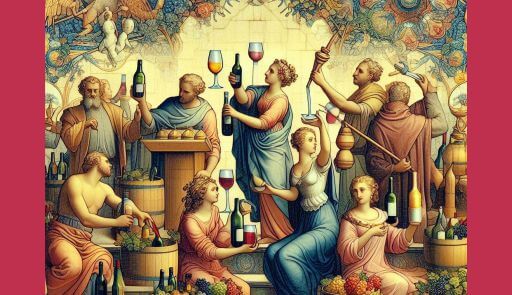
During the Middle Ages, wine appreciation took on a more religious significance as monasteries played a crucial role in preserving and advancing winemaking knowledge.
Monks meticulously tended vineyards and developed new winemaking techniques, elevating the quality of wine production.
In the 18th and 19th Centuries
In the 18th and 19th centuries, wine appreciation began to be seen as a refined and sophisticated practice among the upper classes in Europe.
The French, in particular, developed a culture of wine appreciation that emphasized the importance of terroir (the specific characteristics and influences of a region on the wine) and the art of tasting and describing wines.
Related: Wine and Salmon Pairing Guide
In the 20th Century
In the 20th century, wine appreciation became more widespread and accessible to people from all walks of life.
This was aided by advancements in technology, transportation, and the globalization of wine production.
Wine magazines, wine clubs, and educational courses helped to further increase the knowledge and appreciation of wine among consumers.
Wine Appreciation in Recent Times
Today, wine appreciation is a global phenomenon, with wine lovers and enthusiasts exploring a wide range of varietals and styles from all over the world.
Wine-tasting events, tours, and festivals have become popular activities, allowing individuals to deepen their knowledge and enjoyment of wine.
Related: Guides to Wine and Food Pairing
Importance of Wine Appreciation for Gentlemen
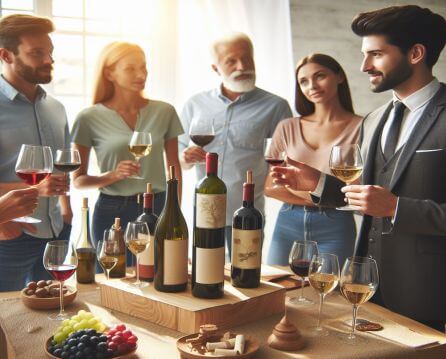
Wine appreciation is not limited to any particular gender, but it is important for gentlemen to develop an understanding and appreciation for wine for several reasons:
1. Social Occasions
Wine is often served at formal gatherings, business dinners, and other social occasions.
By appreciating wine, gentlemen can navigate these events with confidence and contribute to the conversation.
Knowing how to select, order, and pair wines correctly can impress others and elevate your social status.
2. Professional Networking
Wine appreciation can be useful in professional settings, such as client dinners or networking events.
Being knowledgeable about wine can help create connections and promote relationships with important clients or colleagues.
A gentleman who can discuss the intricacies of various grape varieties, regions, and vintages is likely to be seen as sophisticated and cultured, which can enhance his professional reputation.
Related: How to Pair Wines with Ham
3. Personal Enjoyment
Wine appreciation provides gentlemen with the opportunity to savour and enjoy a wide range of flavours and aromas.
By learning about the different types of wine, understanding the tasting notes, and refining their palates, gentlemen can enhance their sensory experiences.
This knowledge allows you as a gentleman to choose wines that suit your personal preferences and enjoy them to the fullest.
4. Cultural Significance
Wine has been an integral part of various cultures for thousands of years.
By appreciating wine, gentlemen can familiarize themselves with the rich history and traditions associated with different winemaking regions.
This cultural knowledge can deepen their understanding of art, literature, history, and other aspects of human civilization.
It can also provide a starting point for engaging in discussions and connecting with people from diverse backgrounds.
5. Health Benefits
Moderate wine consumption has been associated with various health benefits, such as reduced risk of heart disease, certain cancers, and cognitive decline.
By appreciating wine, gentlemen can learn to drink in moderation and make informed choices that support their overall well-being.
Additionally, understanding the different styles of wine and their respective qualities can lead to better decision-making when selecting wines that align with personal health goals.
Related: Appropriate Wines for Lamb
The Basics of Wine Appreciation

Understanding Different Wine Types (red, white, sparkling, rosé)
Wine appreciation begins with understanding the different types of wine.
Red wine is made from dark-colored grapes and typically has a richer, bolder flavor profile. It pairs well with red meats and hearty dishes.
White wine is made from light-colored grapes and is known for its crisp and light flavors.
It pairs well with seafood and light dishes. Sparkling wine refers to any wine that contains bubbles, such as Champagne or Prosecco.
Rosé is a pink-colored wine made from red grapes but with limited contact with the grape skins, resulting in a lighter flavor spectrum.
Exploring Wine Regions and their Characteristics
Wine regions play a significant role in producing unique and distinct flavours in wine.
Each wine region has a specific climate, soil, and grape varieties, which contribute to the characteristics of the wine.
Exploring different wine regions allows wine enthusiasts to appreciate the diversity and nuances in flavor that each region offers.
Learning how to Properly Taste and Evaluate Wine
Wine appreciation involves developing the ability to properly taste and evaluate wine.
This includes observing the wine’s appearance, such as its color and clarity.
Then, the wine is swirled to release its aromas, allowing the taster to evaluate its bouquet.
Taking a small sip, the taster pays attention to the wine’s taste, texture, and balance.
Evaluating the aftertaste and overall impression completes the tasting experience.
Identifying Common Wine Terminology (tannins, acidity, aroma, etc.)
Wine appreciation involves familiarizing yourself with common wine terminology.
Tannins refer to the compounds found in grape skins, seeds, and stems that create a drying sensation in the mouth.
Acidity refers to the level of sharpness or tartness in the wine.
Aroma refers to the smell of the wine, whereas bouquet refers to the combination of scents that develop as the wine ages.
Other important terms include body (referring to the weight or fullness of the wine in the mouth), finish (the impression left after swallowing), and balance (when all components of the wine work harmoniously together).
The Sensory Experience of Wine
The sensory experience of wine involves multiple aspects that contribute to our overall perception and enjoyment of the drink.
These include tasting and evaluating wine, appreciating the aromas and flavours, and observing the visual appeal of the wine.
Tasting and Evaluating Wine: Developing a Discerning Palate
When tasting wine, we rely on our taste buds to detect and evaluate various aspects of the wine’s taste profile.
This includes assessing the balance of sweetness, acidity, and bitterness, as well as identifying specific flavors such as fruit, spices, or oakiness.
To develop a discerning palate, wine enthusiasts often take part in regular wine tastings, where they can practice analyzing and describing different wines.
This practice helps them become more aware of the subtle differences in flavor and texture, enabling them to appreciate and evaluate wines more effectively.
Appreciating the Aromas and Flavors
A significant portion of our sensory experience with wine comes from its aromas and flavours.
The combination of these two elements creates a rich and complex experience that varies from wine to wine.
Aromas
Aromas play a crucial role in how we perceive the taste of wine.
We sniff the wine before tasting it to capture its various scents, which can range from fruity and floral to earthy or herbaceous.
These aromas provide valuable clues about the wine’s origin, grape variety, and winemaking techniques.
Flavours
Flavours, on the other hand, are experienced on the palate. As we take a sip of wine and swish it around our mouth, our taste buds perceive different flavours.
These can include primary flavours derived from the grape variety, secondary flavours resulting from fermentation or aging processes, and tertiary flavours that develop over time as the wine matures.
Understanding the nuances of wine flavours requires practice and exposure to different styles and varieties.
With time, wine enthusiasts can develop the ability to detect and appreciate the subtle and intricate flavors present in each glass of wine.
The Visual Appeal: Observing the Color and Body of Wine
The visual aspect of wine tasting provides important initial information about the wine.
Colour
Observing the color and body of wine can give hints about its age, grape variety, and even the winemaking process.
The color of wine can range from pale straw-like for white wines to deep ruby or purple for red wines.
The intensity and variation in hue within a specific color range can reveal details about the wine’s age and level of oxidation.
For example, white wines tend to darken and become more golden with age, while red wines may develop more garnet or orange tones.
The Body
The body of wine refers to its overall weight or viscosity in the mouth.
Some wines feel light-bodied, while others have a fuller or more robust texture.
This perception of body is determined by factors such as alcohol content, residual sugar, and tannins.
Observing the wine’s body allows us to anticipate its mouthfeel and can give insights into the style and potential age-worthiness of the wine.
Cultivating a Deeper Wine Appreciation
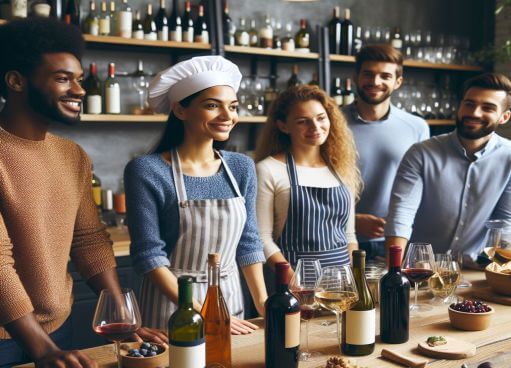
The Role of Terroir and Winemaking Techniques in Wine Appreciation
Cultivating a deeper appreciation for wine involves understanding terroir and winemaking techniques.
Terroir, covering climate, soil, and topography, influences grape characteristics, ultimately affecting wine taste and quality.
Learning about terroir helps enthusiasts appreciate unique regional wines.
Understanding winemaking techniques, including grape selection, fermentation, aging, and barrel selection, enhances wine appreciation by recognizing the craftsmanship and skill behind each bottle.
Terroir and winemaking techniques are crucial in shaping the diverse flavours and qualities of wine, allowing enthusiasts to develop a deeper understanding and admiration for the work that goes into producing exceptional wines.
Exploring the World of Wine: Vineyard Tours and Tastings
Exploring vineyards through tours and tastings is a way to deepen appreciation for wine.
Visiting vineyards allows you as gentleman enthusiast to witness grape-growing firsthand, appreciate the beauty of the vineyards, and understand the labor and dedication involved in wine production.
These tours often provide knowledge about specific grapes, production techniques, and winery history, deepening understanding and appreciation for the wine.
Tastings help develop sensory skills and discern nuances in different wines, allowing you to detect flavours, aromas, and textures, becoming attuned to the complexities within each wine.
Additionally, tastings often involve discussions with experts, providing insights into the winemaking process and expanding knowledge.
Collecting and Cellaring wine: Nurturing a Passion for Oenology:
Collecting and cellaring wine deepens appreciation for oenology.
Building a collection requires knowledge of grape varieties, vintages, and regions, fostering understanding of wine quality and value.
Cellaring allows enthusiasts to witness wine evolution, observing flavour and aroma changes as it matures, fostering a greater appreciation for winemaking and aging complexity.
Wine as a Conversation Starter: Promoting Engaging Discussions
Wine has been a popular choice for social drinking for centuries.
It can serve as a conversation starter and a way to break the ice at social gatherings.
The complexity and variety of wines provide ample opportunities for discussion.
Individuals can share their preferences, knowledge about different wine regions, grape varieties, and tasting experiences.
The act of tasting and discussing wine can create a platform for engaging conversations and allow people to connect over shared interests.
Hosting Wine Tastings and Gatherings: Building a Community of Wine Enthusiasts
Organizing wine tastings and gatherings can bring together like-minded people who share a passion for wine.
These events provide an opportunity for wine enthusiasts to socialize, exchange opinions, and learn from each other.
Hosting these gatherings can cultivate a sense of camaraderie and build a community of people interested in expanding their knowledge and appreciation of wine.
It can also create an environment where people feel comfortable trying new wines and broadening their horizons in a supportive and sociable setting.
The Etiquette of Serving and Enjoying Wine in Social Settings
Wine carries with it a certain degree of etiquette when it comes to serving and enjoying it in social settings.
Understanding and following these etiquettes can enhance the experience for both the host and the guests.
This can include aspects such as proper wine serving temperatures, using appropriate glassware, and knowing how to properly uncork a bottle.
Also, it includes ensuring everyone has enough wine throughout the evening.
Additionally, respecting the preferences of others and providing options for those who may not drink wine can contribute to a more inclusive and enjoyable social engagement.
Adhering to these etiquettes helps create a pleasant and comfortable atmosphere for everyone involved in the social gathering.
Building Your Wine Collection
Building your wine collection involves several important steps.
Here are four key aspects to consider:
Establishing a Budget for Wine Purchases
Before you begin building your wine collection, it’s important to determine your budget.
Decide how much you are willing to allocate towards purchasing wine and be realistic about what you can comfortably spend.
This will help guide your decision-making process and prevent overspending.
Researching and Choosing Wines Based on Personal Preferences
Wine is a highly personal and subjective experience, so it’s important to research and choose wines based on your own preferences.
Experiment with different wine varieties, regions, and styles to discover what you enjoy most.
Attend tastings, read wine reviews, and seek recommendations from knowledgeable wine professionals or friends to further refine your choices.
Proper Storage and Aging of Wine
Wine needs proper storage conditions to maintain its quality and flavor as it ages.
Investing in a wine cooler or cellar that maintains a consistent temperature, humidity, and limited exposure to light and vibration is essential for long-term storage.
Understanding the aging potential of different wines will also help you determine when to open them and at what stage they offer the best drinking experience.
The Art of Sharing and Celebrating Wine
Wine has long been a symbol of conviviality and culture, bringing people together to share in its pleasures and traditions.
The art of sharing and wine appreciation extends beyond the simple act of uncorking a bottle.
It encompasses the communal joy of hosting wine-centric events, embracing wine as a cultural ambassador, and considering the future of wine appreciation in the context of innovation and sustainability.
Sharing the Joy of Wine: Hosting Wine-centric Events and Celebrations
Hosting wine-centric events provides an opportunity to share the love of wine with friends, family, and fellow enthusiasts.
Whether it’s a casual gathering, a formal dinner, or a themed tasting event, these occasions allow for the exploration and enjoyment of different varietals and vintages.
The convivial atmosphere fosters engaging conversations and creates lasting memories centered around the appreciation of wine.
Wine as a Cultural Ambassador: Embracing Diversity and Global Wine Traditions
Wine is a reflection of diverse cultures and traditions from around the world.
Embracing this diversity involves exploring and appreciating the unique stories behind different wines and winemaking regions.
By understanding the cultural significance of wine, you can develop a deeper appreciation for its historical and regional context, recognizing it as a universal ambassador of heritage and tradition.
The Future of Wine Appreciation: Embracing Innovation and Sustainability
As the world of wine continues to evolve, it is essential to consider the future of wine appreciation in the context of innovation and sustainability.
Embracing innovation involves exploring new winemaking techniques, technological advancements, and emerging trends that shape the industry.
Additionally, sustainability plays a crucial role in preserving the environment and the longevity of the wine industry, encouraging responsible consumption and eco-friendly practices.
Tips for Expanding your Wine Collection
To expand your wine collection, consider the following tips:
- Join a Wine Club or Subscription Service: These provide curated selections of wines delivered to your door, allowing you to discover new options and broaden your taste preferences.
- Attend Wine Tastings and Events: Attending tastings and events is an excellent way to try a variety of wines, learn from experts, and meet other wine enthusiasts who can offer recommendations.
- Explore Different Wine Regions: Expand your collection by exploring wines from different countries and regions. Each region has unique grape varieties and winemaking styles that can add diversity to your collection.
- Visit Wineries: Visiting wineries offers the opportunity to taste wines directly from the source and often purchase wines that may not be widely available elsewhere. It also provides a chance to learn about the winemaking process and gain insights from winemakers themselves.
- Document Your Wine Experiences: Keep a wine journal or use wine apps to track your tasting notes and preferences. This serves as a helpful reference and can guide future purchasing decisions.
Frequently Asked Questions
What does it mean to appreciate wine?
Appreciating wine means understanding its nuances, history, and cultural significance, and savoring its sensory experience with respect and curiosity.
How do you appreciate wine?
You appreciate wine by learning about its varietals, tasting techniques, and food pairings, and by exploring its regional diversity and traditions.
What is the word for wine appreciation?
The word for wine appreciation is “oenology” or “oenophilia,” reflecting a deep love and knowledge of wine.
How do you start wine appreciation?
You can start wine appreciation by attending tastings, reading about wine, visiting vineyards, and engaging with fellow enthusiasts to deepen your understanding and enjoyment.
Final Word
Wine appreciation is a journey that transcends the mere act of sipping a glass of wine.
It covers an understanding of the grape, the terroir, and the artistry of winemaking.
It involves savouring, feeling the sensory of aromas and flavours, embracing the cultural tapestry woven into each bottle, and promoting a community of enthusiasts.
Appreciation of wine is a celebration of history, diversity, and craftsmanship, inviting us to raise our glasses to the timeless allure of the noble grape.
References:
- https://manatawnycreekwinery.com/resources/faq/wine-appreciation-faq
- https://ewineasia.com/blog/beginners-guide-to-wine-appreciation-tasting
- https://foodandwineaesthetics.com/2021/03/10/wine-appreciation-irony-and-a-game-of-striving/
Pyo Merez, a social psychologist and avid writer, specializes in unraveling the intricate relationship between gentlemen and society.
With years of experience studying human behaviour, he offers unique insights into how societal norms shape gentlemen’s identity and vice versa.
Through his captivating and thought-provoking articles, Pyo taps into the depths of gentlemanliness and masculinity and provides valuable perspectives on etiquette and manners in modern society.
Prepare to embark on an enlightening journey with Pyo Chims as he dives deep into the world of gentlemen’s culture and society.
